| Sample No.: | QUE93017 |
| Location: | Queen Alexandra Range |
| Dimensions (cm): | 2.5 x 2.2 x 2.0 |
| Weight (g): | 8.8 |
| Meteorite Type: | C2 Chondrite |
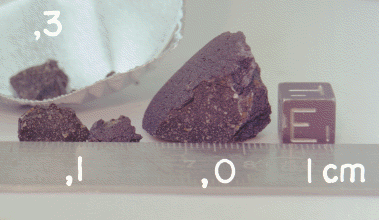
Macroscopic Description: Robbie Marlow
Dull black fusion crust covers 60% of the exterior of this carbonaceous
chondrite. Evaporite deposit is present on some surfaces and
some surface fracturing is visible. The interior matrix is black
with abundant millimeter-sized white inclusions. The matrix is
fined grained and evenly textured.
Thin Section (,2) Description: Brian Mason
The section shows a few chondrules, up to 0.6 mm across, some
irregular aggregates, and numerous small silicate grains in a
black matrix. The silicate grains are almost entirely olivine
near Mg2SiO4 in composition, with a few more iron-rich grains.
A little pyroxene near MgSiO3 in composition is present. The
matrix appears to consist largely of iron-rich serpentine. The
meteorite is a C2 chondrite; it is very similar to QUE93004 and
93006, with which it is probably paired.
| Sample No.: | QUE93018 |
| Location: | Queen Alexandra Range |
| Dimensions (cm): | 1.5 x 1.1 x 0.8 |
| Weight (g): | 1.3 |
| Meteorite Type: | C2 Chondrite |
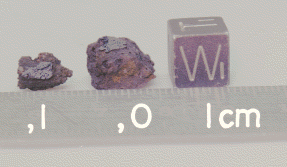
Macroscopic Description: Robbie Marlow
The exterior of this carbonaceous chondrite has patches of dull
black fusion crust. Areas devoid of fusion crust are dull black
and porous. The interior matrix is black and fine grained. One
millimeter-sized dark clast is visible.
Thin Section (,2) Description: Brian Mason
The section shows rare chondrules up to 0.5 mm across, and numerous
small silicate grains in a dark brown to black matrix. Most of
the chondrules have been converted into brown serpentine. Trace
amounts of nickel-iron and troilite are present as minute grains.
Olivine is near Mg2SiO4 in composition, with a few more iron-rich
grains. The matrix appears to consist largely of iron-rich serpentine.
The meteorite is a C2 chondrite; it is very similar to QUE93005,
with which it is probably paired.
| Sample No.: |
QUE93513 |
| Location: | Queen Alexandra Range |
| Dimensions (cm): | 0.5 x 0.4 x 0.2 |
| Weight (g): | 0.2 |
| Meteorite Type: | E4 Chondrite |
Macroscopic Description: Carol Schwarz
Approximately 50% of this tiny rusty and fractured fragment is
covered with dark reddish brown fusion crust. Some metal is visible.
The entire sample is now embedded in epoxy.
Thin Section (,1) Description: Brian Mason
The section shows an aggregate of chondrules and chondrule fragments,
up to 1.2 mm across, and mineral grains in a moderate amount of
black matrix. The chondrules and mineral grains consist almost
entirely of pyroxene, with possible traces of olivine. The matrix
contains a moderate amount of nickel-iron and sulfides. Weathering
is extensive, with veinlets and patches of brown limonite throughout
the section. Microprobe analyses show that the pyroxene is close
to MgSiO3 in composition (FeO 0.7-1.8%, CaO 0.2-0.6%). The nickel-iron
contains 2.1-2.4% Si. One grain of roedderite, NaKMg5Si12O30,
was analyzed. The meteorite is classified as an E4 chondrite.
| Sample No.: |
QUE93517; QUE93575; QUE93584; QUE93586 | |
| Location: | Queen Alexandra Range | |
| Dimensions (cm): | 1.2 x 0.9 x 0.4; 1.5 x 0.8 x 0.4; 2.7 x 2.1 x 1.7; 1.0 x 0.8 x 0.4 | |
| Weight (g): | 0.9; 1.5; 24.3; 0.8 | |
| Meteorite Type: | Mesosiderite |
Thin Section (QUE93517,1; 93575,2; 93584,2; 93586,1) Description: Brian Mason
Microprobe analyses of these sections show a wide range of pyroxene
compositions (Fs14-57). The meteorites are classified as mesosiderites.
They are very similar to the larger mesosiderite QUE86900 (Antarctic
Meteorite Newsletter 10(2), 1987), with which they are probably
paired.
| Sample No.: |
QUE93520 |
| Location: | Queen Alexandra Range |
| Dimensions (cm): | 1.5 x 1.0 x 0.9 |
| Weight (g): | 1.8 |
| Meteorite Type: | L3 Chondrite (estimated L3.5) |
Thin Section (,2) Description: Brian Mason
The section shows numerous chondrules and chondrule fragments
(up to 1.8 mm across) in a black matrix which contains small amounts
of nickel-iron and troilite. Brown limonitic staining pervades
the section. Microprobe analyses show a wide range of olivine
and pyroxene compositions: olivine, Fa1-21, mean Fa14; pyroxene,
Fs4-42. The meteorite is an L3 chondrite (estimated L3.5).
| Sample No.: |
QUE93523 |
| Location: | Queen Alexandra Range |
| Dimensions (cm): | 0.8 x 0.6 x 0.3 |
| Weight (g): | 0.4 |
| Meteorite Type: | E4 Chondrite |
Thin Section (,1) Description: Brian Mason
The section shows an aggregate of chondrules and chondrule fragments,
up to 1.2 mm across, and mineral grains in a moderate amount of
black matrix. The chondrules and mineral grains consist almost
entirely of pyroxene, with accessory olivine in a few chondrules.
Polysynthetic twinning is present in some of the pyroxene. The
matrix contains a moderate amount of nickel-iron and sulfides.
Weathering is extensive, with veinlets and patches of brown limonite
throughout the section. Microprobe analyses show that the pyroxene
is close to MgSiO3 in composition (FeO 0.4-1.9%, CaO 0.1-0.6%).
The nickel-iron contains 2.8% Si. The meteorite is classified
as an E4 chondrite. It is very similar to QUE93513, with which
it is probably paired.
| Sample No.: |
QUE93544 |
| Location: | Queen Alexandra Range |
| Dimensions (cm): | 1.8 x 1.0 x 0.5 |
| Weight (g): | 3.3 |
| Meteorite Type: | Pallasite |
Thin Section (,2) Description: Brian Mason
The section consists almost entirely of nickel-iron, with a few
anhedral grains of olivine, up to 0.6 mm across, at one margin.
The section is rimmed with brown limonite, evidently the product
of weathering. Olivine composition is Fa12. The specimen appears
to be a fragment of a pallasite.
| Sample No.: |
QUE93607 |
| Location: | Queen Alexandra Range |
| Dimensions (cm): | 1.2 x 0.9 x 0.5 |
| Weight (g): | 1.5 |
| Meteorite Type: | L3 Chondrite (estimated L3.5) |
Thin Section (,2) Description: Brian Mason
The section shows numerous chondrules (up to 1.2 mm across), chondrule
fragments, and mineral grains in a small amount of black matrix.
The matrix contains moderate amounts of nickel-iron and sulfide.
Weathering is extensive, with brown limonitic staining throughout
the section. The section is partially rimmed with fusion crust.
Microprobe analyses show a wide range of olivine and pyroxene
compositions: olivine, Fa1-32, mean Fa13; pyroxene, Fs4-25. The
meteorite is classified as an L3 chondrite (estimated L3.5).
| Sample No.: |
QUE93639 |
| Location: | Queen Alexandra Range |
| Dimensions (cm): | 1.8 x 1.0 x 0.6 |
| Weight (g): | 1.6 |
| Meteorite Type: | CV3 Chondrite |
Thin Section (,2) Description: Brian Mason
The section shows numerous chondrules and irregular aggregates,
up to 1.5 mm across, in a black matrix. A small amount of nickel-iron
and troilite is present at the rims and within the chondrules.
Microprobe analyses show that most of the olivine in the chondrules
is close to Mg2SiO4 in composition, but ranges up to Fa17; pyroxene
composition is Fs1-11. The matrix appears to consist largely
of iron-rich olivine, about Fa50. The meteorite is classified
as a C3 chondrite of the Vigarano subtype; it is very similar
to QUE93429, with which it is probably paired.
| Sample No.: |
QUE93705 |
| Location: | Queen Alexandra Range |
| Dimensions (cm): | 3.8 x 3.4 2.0 |
| Weight (g): | 55.0 |
| Meteorite Type: | L3 Chondrite (estimated L3.7) |
Thin Section (,2) Description: Brian Mason
The section shows numerous chondrules (up to 1.8 mm across), chondrule
fragments, and mineral grains in a small amount of black matrix.
The matrix contains a small amount of nickel-iron and troilite.
Weathering is extensive, with brown limonitic staining throughout
the section. Microprobe analyses shows a considerable range in
olivine and pyroxene compositions: olivine, Fa6-19, mean Fa14;
pyroxene, Fs2-19. The meteorite is classified as an L3 chondrite
(estimated L3.7).
| Sample No.: |
QUE93723 |
| Location: | Queen Alexandra Range |
| Dimensions (cm): | 2.8 x 2.1 x 1.3 |
| Weight (g): | 15.4 |
| Meteorite Type: | Howardite |
Thin Section (,3) Description: Brian Mason
The section is a microbreccia of pyroxene with minor plagioclase,
and a few minute opaque grains. Individual clasts range up to
1.8 mm across. Microprobe analyses show that pyroxene compositions
range fairly uniformly from Wo2Fs22 to Wo15Fs50; plagioclase compositions
range from An80 to An94. One grain of SiO2, probably tridymite,
and one grain of ilmenite were analyzed. The meteorite is classified
as a howardite.
| Sample No.: |
QUE93744 |
| Location: | Queen Alexandra Range |
| Dimensions (cm): | 2.0 x 1.6 x 1.0 |
| Weight (g): | 7.7 |
| Meteorite Type: | CV3 Chondrite |
Thin Section (,2) Description: Brian Mason
The section shows numerous chondrules and irregular aggregates,
up to 1.5 mm across, in a black matrix. The matrix contains accessory
amounts of nickel-iron and troilite. Microprobe analyses show
that most of the olivine in the chondrules is close to Mg2SiO4
in composition, but ranges up to Fa10; pyroxene composition is
Fs1-2. The matrix appears to consist largely of iron-rich olivine,
about Fa50. The meteorite is classified as a C3 chondrite of
the Vigarano subtype; it is very similar to QUE93429 and 93639,
with which it is probably paired.
| Sample No.: | LON94100 |
| Location: | Lonewolf Nunataks |
| Dimensions (cm): | 13.5 x 9.5 x 8.0 |
| Weight (g): | 1947.1 |
| Meteorite Type: | E6 Chondrite |
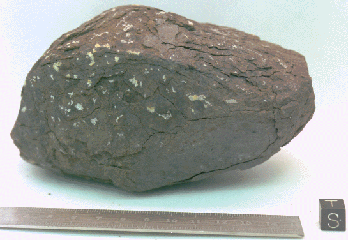
Macroscopic Description: Kathleen McBride
This meteorite is shaped like a volcanic bomb and has a rusty-colored,
exfoliating, flaky exterior. It is dull on one side and shiny
on the opposite side. Thick evaporitic material is present on
two exterior surfaces. The flaky crust has numerous surface cracks
that do not penetrate the interior and run mostly in the longitudinal
direction. The weathered crust extends a few millimeters into
the interior. The interior is very fresh compared to the exterior
and proved to be very coherent and extremely hard. The interior
is fine-grained and varies in color from steel-gray to black with
interstitial white to clear crystals.
Thin Section (,6) Description: Brian Mason
Only vague traces of chondritic structure are visible in the thin
section, which shows the meteorite to consist largely of granular
to prismatic enstatite (grain size 0.1-0.2 mm), about 20% nickel-iron,
minor amounts of sulfides, and a little plagioclase. The enstatite
is almost pure MgSiO3 (Fe 0.1-0.6%, Ca 0.7-0.9%). The metal contains
0.9% Si. One grain of plagioclase, An17, was analyzed. The meteorite
is an E6 chondrite.
| Sample No.: | LON94101 |
| Location: | Lonewolf Nunataks |
| Dimensions (cm): | abundant pieces |
| Weight (g): | 2804.6 |
| Meteorite Type: | C2 Chondrite |

Macroscopic Description: Kathleen McBride
LON94101 consists of abundant friable pieces, none of which fit
together. This sample contains small (2-3 cm) patches of purplish-red
fusion crust. It is black, heavily fractured, and contains green
inclusions in the millimeter to centimeter size range. There
are also some rusted clasts and small (<1 mm) angular white
flecks. The exterior has a greenish tinge where the interior
is black. Interior clasts consist of angular tan colored inclusions
that are ~3-4 mm in size. Also visible are several rounded white
clasts with a sugary texture that are about 3 mm in diameter.
Thin Section (,12 and ,14) Description: Brian Mason
The sections show a few chondrules, up to 0.4 mm across, some
irregular aggregates, and numerous small mineral grains in a black
matrix. LON94101,12 has two pale green-gray granular enclaves,
one 2.9 mm and the other 1.8 mm across. The mineral grains are
almost entirely olivine, near Mg2SiO4 in composition, with a few
iron-rich grains. A small amount of pyroxene, near MgSiO3 in
composition, is present. The matrix consists largely of iron-rich
serpentine. The larger enclave consists almost entirely of serpentine,
similar in composition to the matrix. The smaller enclave consists
largely of enstatite (Fs1-3), with a little olivine (Fa2) and
some carbonate grains, both calcite and dolomite. The meteorite
is a C2 chondrite.
| Sample No.: | LON94102 |
| Location: | Lonewolf Nunataks |
| Dimensions (cm): | ~10 x 10.5 x 4.5 |
| Weight (g): | 941.6 |
| Meteorite Type: | C2 Chondrite |

Macroscopic Description: Kathleen McBride
LON94102 consists of one large fragment and one small piece that
do not fit together but are definitely pieces of the same carbonaceous
chondrite. Approximately 5% of the dull, pitted fusion crust
remains on this specimen. The exterior matrix is black and contains
numerous small white angular inclusions. Small areas have oxidized
to a red-brown color. Fractures that penetrate the interior are
numerous. Slickenside-like features are visible on the surface.
Evaporite deposit is present. The sample is friable and easily
crumbled when trying to obtain a chip for thin sections.
Thin Section (,11) Description: Brian Mason
The section shows a few chondrules, up to 0.6 mm across, some
irregular aggregates, and numerous small mineral grains in a black
matrix. The mineral grains are almost entirely olivine, near
Mg2SiO4 in composition, with a few iron-rich grains. A small
amount of pyroxene, near MgSiO3 in composition, is present. The
matrix consists largely of iron-rich serpentine. The meteorite
is a C2 chondrite. It is very similar to LON94101, and the possibility
of pairing should be considered.
| Sample No.: | QUE94200 |
| Location: | Queen Alexandra Range |
| Dimensions (cm): | 5.3 x 5.2 x 3.8 |
| Weight (g): | 165.4 |
| Meteorite Type: | Howardite |
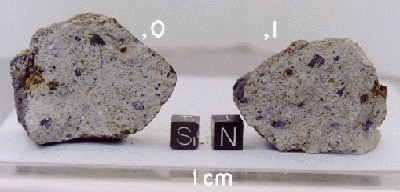
Macroscopic Description: Cecilia Satterwhite
The exterior of this meteorite has dull, black fusion crust that
is patchy on some surfaces. Areas devoid of fusion crust have
a dull gray color. Some small green, black, and white minerals
are visible. The interior of this meteorite is light gray and
contains abundant, mostly small inclusions; however, a few larger
inclusions are present. The inclusions are white, green-black,
and gray in color. The black inclusions are the largest; one
rounded inclusion is 0.6 cm. Other black inclusions vary in size
from 0.2 to 0.5 cm. One basaltic clast is visible. Weathering
is minor.
Thin Section (,5) Description: Brian Mason
The section shows a microbreccia of pyroxene and plagioclase clasts
in a comminuted groundmass of these minerals. The pyroxene is
orthopyroxene with a minor amount of pigeonite; orthopyroxene
clasts are up to 1.8 mm across, whereas pigeonite clasts are smaller
(maximum 0.3 mm). Microprobe analyses show pyroxene compositions
ranging from Wo1Fs18 to Wo11Fs43. Plagioclase compositions range
from An74 to An93. Accessory amounts of an SiO2 mineral, probably
tridymite, are present. The meteorite is a howardite.
| Sample No.: | QUE94201 |
| Location: | Queen Alexandra Range |
| Dimensions (cm): | 2.3 x 2.0 x 1.5 |
| Weight (g): | 12.0 |
| Meteorite Type: | Shergottite |
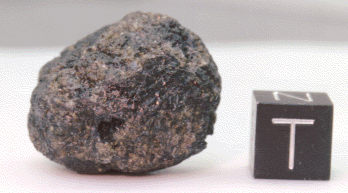
Macroscopic Description: Roberta Score
This small, dark-gray to black stone is rounded and polished.
The spotty, brownish-black, remnant fusion crust is difficult
to distinguish from the melted, glassy grains on the exterior
surface. The interior is coarse-grained, crystalline, and glassy.
It is composed of laths or globular grains of transparent or
translucent maskelynite plus dull or glassy-black pyroxene. Several
mafic-rich areas, as large as 5 x 4 mm, were noted. Oxidation
is scattered throughout the interior. Thick evaporite minerals
are concentrated as small blebs.
Thin Section (,3) Description: Brian Mason
The section shows a coarse-grained aggregate of subequal amounts
of pyroxene and maskelynite; the maskelynite as laths up to 3.6
mm long, and the pyroxene as interstitial anhedral to subhedral
grains. Maskelynite is fairly uniform in composition, An55-64.
The pyroxene is pigeonite of variable composition, Wo9-20 and
Fs21-69. The meteorite is a shergottite.
| Sample No.: | QUE94269 |
| Location: | Queen Alexandra Range |
| Dimensions (cm): | 1.9 x 1.4 x 1.3 |
| Weight (g): | 3.2 |
| Meteorite Type: | Lunar-Anorthositic Breccia |
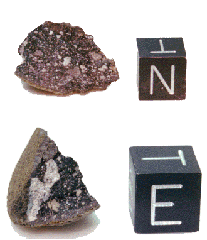
Macroscopic Description: Roberta Score
This lunar meteorite is identical to QUE93069 and would probably
fit together if QUE93069 was still in one piece. One side of
this flat stone has thick gray-green, frothy fusion crust. The
other side has thin, weathered, dull green-brown fusion crust.
A fractured surface reveals the interior matrix which is dark
gray to black with abundant inclusions. The largest inclusion
is white and measures 1.0 x 0.2 cm. The newly exposed interior
surface has a lighter gray-colored matrix and abundant white and
gray clasts. One white clast measures 0.4 x 0.2 cm. Other inclusions
present include fine-grained, buff-colored clasts, several brecciated
gray clasts, and smaller white clasts. Many clasts have weathered
to a yellowish color. As in QUE93069, most of the clasts are
small and friable and, unfortunately, are not extractable.
Thin Section (,5 and ,7) Description: Brian Mason
The sections show a microbreccia of granular clasts, up to 1.5
mm across, and small plagioclase grains, in a translucent to semi-opaque
brown glassy matrix; one grain of metallic iron, 0.3 mm across,
was noted. Most of the plagioclase is almost pure anorthite (Na2O
0.3-0.5%, K2O less than 0.1%), with a few grains with higher Na2O,
up to 3.2%. QUE94269,7 has a 3 mm clast of subequal amounts of
plagioclase and pyroxene; the plagioclase is anorthite (Na2O 0.3-0.5%),
the pyroxene ranges from Wo5Fs39 to Wo34Fs22 with fairly uniform
En content. This specimen is a lunar meteorite, very similar
to QUE93069 (Antarctic Meteorite Newsletter 17(2), 1994), with
which it is certainly paired.
| Sample No.: | QUE94281 |
| Location: | Queen Alexandra Range |
| Dimensions (cm): | 4.0 x 3.1 x 1.0 |
| Weight (g): | 23.4 |
| Meteorite Type: | Lunar-Basaltic Breccia |

Macroscopic Description: Roberta Score and Marilyn Lindstrom
This is a very strange meteorite. It is highly glassy and inhomogeneous.
The exterior is black with thick, shiny glass on one side and
an irregular, rough surface on the other. The glass is black,
conchoidal, vesicular in places, and has melted into many of the
abundant cavities. The interior is very inhomogeneous. This
meteorite is wedge-shaped, ranging in thickness from 3 mm to 10
mm. At the thin end, the rough black material has small white
flecks in it, while the middle region consists of a chaotic aphanitic
material. The thick end is a coarse-grained breccia with abundant
angular white, yellow, and black mineral and lithic clasts up
to 3 mm across. Two 2 mm-thick glassy, vesicular, black veins
cut across the different areas. Oxidation is lightly scattered
throughout the meteorite. It will be difficult to do detailed
sampling of this complex breccia.
Thin Section (,4) Description: Brian Mason
The section shows a microbreccia of pale brown pyroxene and colorless
plagioclase clasts, up to 1.2 mm across, in a comminuted groundmass
of these minerals. Colorless fusion crust rims part of the section,
which is cut by a 1 mm-wide veinlet of vesicular black glass.
Pyroxene compositions show a wide range: Wo4-30, Fs23-55, En25-66.
Plagioclase composition is An91-97. A little olivine, Fa33-36,
was analyzed, and one grain of silica polymorph, probably tridymite.
Fusion crust composition is SiO2 47, Al2O3 16, FeO 13, MgO 9.1,
CaO 12, K2O <0.1, TiO2 0.6, MnO 0.2, Na2O 0.5. The black glass
has a similar but somewhat variable composition. The high FeO:MnO
ratio indicates a lunar origin, and the meteorite has a composition
of a basalt-rich breccia. Its composition appears to be intermediate
between those of EET87521 (Geochim. Cosmochim Acta, v. 53, p.
3323, 1989) and Calcalong Creek (Nature, v. 352, p.614, 1991)
and very similar to that of Y793274 (Proc. NIPR Symp. Antarct.
Meteorites, v. 4, p. 3, 1991).